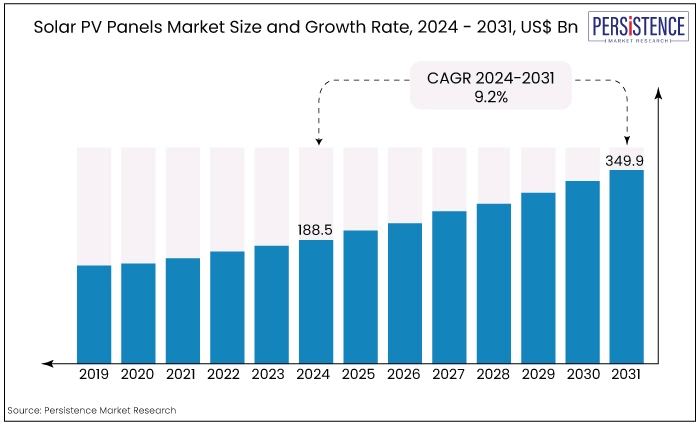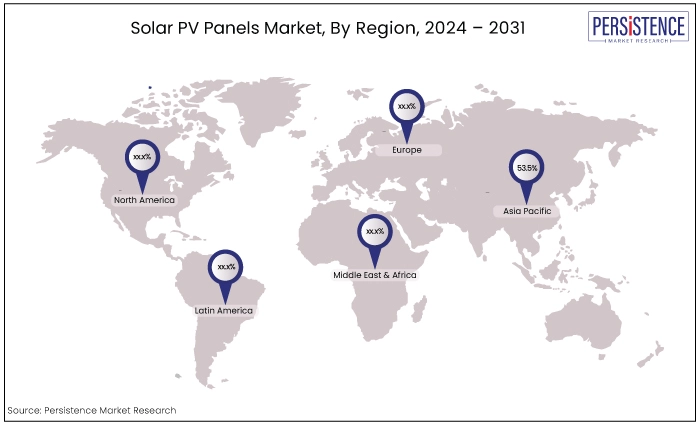Industry: Industrial Automation
Format: PPT*, PDF, EXCEL
Delivery Timelines: Contact Sales
Report Type: Ongoing
Report ID: PMRREP34658
The global market for solar PV panels is expected to rise from US$188.5 Bn in 2024 to US$349.9 Bn by the end of 2031. The market is anticipated to secure a CAGR of 9.2% during the forecast period from 2024 to 2031.
Key Highlights of the Market
|
Attributes |
Key Insights |
|
Market Size (2024E) |
US$188.5 Bn |
|
Projected Market Value (2031F) |
US$349.9 Bn |
|
Forecast Growth Rate (CAGR 2024 to 2031) |
9.2% |
|
Historical Growth Rate (CAGR 2019 to 2023) |
8.7% |
Solar photovoltaic panels are silicon panels capable of capturing photons or sunlight and converting them into electricity.
The solar photovoltaic panels get their name from a process called PV effect, discovered in 1954, which involves converting photons into voltage (light into electricity). Solar photovoltaic panels also go by the name solar cells or solar panels.
Solar photovoltaic panels consist of photovoltaic cells made up of silicon. Second generation of solar photovoltaic panels are called thin film solar cells which are made from thin layers of non-silicon materials like cadmium telluride or amorphous silicon.
These are more flexible as compared to the first generation of solar photovoltaic panels, and are often used in building facades, rooftop shingles or glazing.
With advancements in technology, the third generation of solar photovoltaic panels are now made of a range of materials besides silicone, like conductive plastics, solar dyes and solar inks.
Some solar photovoltaic panels even use mirrors or plastic lenses to concentrate light onto a very high efficient, yet small PV panel.
Increasing concerns for carbon emissions and gradual shift towards dependence on renewable sources for energy consumption are some of the prime factors expected to drive the solar PV panels market growth in the coming years.

The market witnessed a consistent upward trend throughout the historical period. Growing concerns about climate change and a desire for energy independence propelled the adoption of solar energy.
Technological advancements and increased manufacturing capacity led to a significant decrease in the cost of solar panels, making them more attractive to consumers.
Many governments introduced subsidies, tax breaks, and net metering policies to encourage solar panel installations. The market expanded at a CAGR of 8.7% during the historical period from 2019 to 2023.
The solar PV panels market is poised for continued robust growth in the coming years. The growing urgency to address climate change and achieve net-zero emissions will be a major driver.
Solar energy is expected to play a central role in this transition, with governments worldwide setting ambitious renewable energy target.
As solar panel prices continue to decline and approach grid parity (the point where solar electricity becomes cost-competitive with traditional sources), adoption is expected to accelerate across all sectors, including residential, commercial, and industrial. The market for solar PV panels is projected to hold a CAGR of 9.2% during the forecast period.
Advancements in Energy Storage Technology
Recent breakthroughs in energy storage technology have revolutionized the solar PV market by addressing one of its longstanding challenges: intermittency.
Energy storage solutions, such as lithium-ion batteries and other emerging technologies like flow batteries and hydrogen storage, have significantly enhanced the reliability and flexibility of solar PV systems.
These advancements allow solar energy to be stored during periods of peak generation and dispatched when demand is high or solar generation is low, thereby optimizing energy utilization and grid stability.
Energy storage systems integrated with solar PV installations offer several benefits. They enable grid operators to manage fluctuations in renewable energy generation more effectively, reduce reliance on back-up fossil fuel generators, and enhance the overall resilience of the electricity grid.
Energy storage enhances the economic viability of solar PV projects by enabling the sale of stored energy during peak demand periods, thereby maximizing revenue potential for project developers and investors.
Technological innovations in energy storage are driving down costs and improving performance metrics such as efficiency, cycle life, and safety.
As a result, the combined deployment of solar PV and energy storage systems is becoming increasingly attractive across residential, commercial, industrial, and utility-scale applications worldwide. This trend is particularly pronounced in regions with high solar penetration and ambitious renewable energy targets
Growing Commitment of Corporations to Procure Renewable Energy
Another significant driver influencing the solar PV panels market is the growing commitment of corporations to procure renewable energy as part of their sustainability strategies.
Leading corporations across various sectors, including technology, manufacturing, retail, and finance, are setting ambitious renewable energy targets to reduce their carbon footprints and enhance their environmental stewardship.
Solar PV panels are a preferred choice for corporate renewable energy procurement due to their scalability, reliability, and relatively short payback periods.
Corporate power purchase agreements (PPAs) with solar developers enable businesses to secure long-term, fixed-price contracts for renewable energy, thereby hedging against future energy price volatility and supporting financial planning.
Investing in solar PV installations allows companies to demonstrate corporate social responsibility (CSR), enhance brand reputation, and meet stakeholder expectations regarding environmental sustainability. These factors are compelling businesses to integrate renewable energy sources like solar PV into their operational strategies and supply chains.
Supply Chain Disruptions, and Material Costs
Recent years have seen significant disruptions in global supply chains, exacerbated by geopolitical tensions, trade policies, and the COVID-19 pandemic. These disruptions have affected the availability and cost of raw materials crucial for manufacturing solar PV panels, such as silicon, aluminum, and various chemicals used in panel production.
The solar PV industry heavily relies on silicon as the primary material for photovoltaic cells, and any fluctuations in silicon prices or supply chain interruptions can directly impact panel manufacturing costs.
Moreover, logistical challenges and delays in transporting components and finished products further strain supply chains, leading to project delays and increased procurement costs for developers and installers.
Fluctuations in exchange rates and import or export tariffs imposed by different countries can add unpredictability to material costs and procurement strategies for solar PV manufacturers and suppliers.
Such uncertainties hinder long-term planning and investment in solar PV projects, particularly in emerging markets where regulatory environments may already present challenges
Policy and Regulatory Uncertainty
The solar PV panels market is heavily influenced by government policies, regulations, and incentives that shape market dynamics and investment decisions.
However, uncertainty surrounding policy frameworks, changes in regulations, and inconsistent support mechanisms can create barriers to market entry and hinder the growth of solar PV installations.
In some regions, shifts in political leadership or policy priorities can lead to delays in implementing supportive policies for renewable energy, including solar PV. This uncertainty complicates project planning and financing, as developers and investors require stable and predictable regulatory environments to justify long-term investments in solar PV projects.
Changes in tariff structures, grid connection requirements, and net metering policies can impact the economics of solar PV installations, affecting the attractiveness of solar energy investments for consumers, businesses, and utilities alike.
Unclear or ambiguous regulations may also lead to disputes and legal challenges, further delaying project development timelines and increasing costs.
Integration with Emerging Technologies
The integration of solar PV panels with energy storage systems, such as lithium-ion batteries, pumped hydro storage, and emerging technologies like flow batteries and hydrogen storage, unlocks new possibilities.
Energy storage addresses intermittency issues associated with solar power generation, enabling better grid management, peak shaving, and improved energy independence.
As storage technologies continue to advance in terms of cost-effectiveness, efficiency, and scalability, the combined deployment of solar PV and storage systems becomes increasingly attractive across residential, commercial, and utility-scale applications.
Smart grid technologies facilitate real-time monitoring, demand response, and efficient energy management. By integrating solar PV panels with smart grid infrastructure, utilities can optimize grid operations, enhance reliability, and accommodate higher penetrations of renewable energy.
Digitalization and data analytics further empower stakeholders to optimize solar PV performance, predict maintenance needs, and maximize energy yield, thereby improving overall system economics and customer satisfaction.
Expansion in Emerging Markets, and Decentralized Energy Solutions
Rapid urbanization, economic growth, and increasing energy demand in emerging markets create a fertile ground for solar PV adoption. Government initiatives, favorable regulatory frameworks, and declining technology costs stimulate investment in solar PV infrastructure.
Moreover, off-grid and mini-grid solutions powered by solar PV provide reliable electricity access to remote and underserved communities, unlocking socio-economic benefits and improving quality of life.
Distributed generation and decentralized energy solutions powered by solar PV panels empower consumers and businesses to generate their own electricity, reduce reliance on centralized utilities, and lower energy costs.
Peer-to-peer energy trading platforms leveraging blockchain technology enable consumers to trade surplus solar energy directly with neighbors or businesses, fostering energy independence and community resilience.
As consumers prioritize sustainability and seek alternative energy solutions, decentralized solar PV installations offer flexibility, reliability, and environmental benefits.
Thin-film Segment to Record Notable Share in the Market
|
Category |
Market Share in 2023 |
|
Thin-film – By Technology |
41.50% |
Advancements in thin-film technology have led to improvements in efficiency and performance. While initially less efficient than crystalline silicon panels, thin-film technologies such as CIGS have made significant strides in enhancing their conversion efficiency.
The thin-film segment exhibited significant market share of over 41.50% in 2023. Segment growth is due to increased durability and compact design of thin-film solar PV panels.
Thin-film solar panels offer flexibility in terms of installation and design, which appeals to a wide range of applications beyond traditional rooftop installations. Thin-film panels are lightweight and can be integrated into building materials, such as roofs, facades, and even windows.
Industrial Sector to Account for Dominant Share in the Market
|
Category |
Market CAGR through 2031 |
|
Industrial - By Application |
7.8% |
The industrial segment is projected to expand at a significant CAGR of 7.8% during the projection period. Industrial sectors have a substantial and growing demand for reliable and cost-effective energy solutions.
Solar PV panels offer a sustainable alternative to traditional energy sources, helping industries reduce operational costs and mitigate environmental impact.
As industries prioritize energy efficiency and sustainability goals, solar PV installations become increasingly attractive for powering manufacturing facilities, warehouses, distribution centers, and industrial complexes.
Asia Pacific Continues Hold Largest Market Share
|
Region |
Market Share in 2023 |
|
Asia Pacific |
53.5% |
Asia Pacific continues to hold the largest market share in the projection period. Governments across the Asia Pacific region have implemented robust policies and incentives to promote renewable energy, including solar PV. Asia Pacific market held 53.5% share in 2023.
Asia Pacific is home to some of the world's fastest-growing economies, leading to increased energy demand for industrialization, urbanization, and infrastructure development.
Solar PV panels offer a scalable and sustainable solution to meet this growing energy demand while reducing reliance on imported fossil fuels.
The cost-competitiveness of solar PV technology makes it an attractive option for countries seeking energy security and economic stability through diversified energy sources.

Continuous research and development efforts focus on improving the efficiency and performance of solar PV panels. Innovations in materials, cell designs, and manufacturing processes aim to increase conversion efficiency, reduce production costs, and enhance durability and reliability.
Companies investing in thin-film technologies, such as First Solar (CdTe) and Hanergy (CIGS), are pushing the boundaries of efficiency and flexibility, offering alternatives to traditional crystalline silicon panels.
Collaborations between solar panel manufacturers, energy storage providers, and technology firms (e.g., AI and IoT companies) drive innovation and enable comprehensive energy solutions.
October 2023
The Government has introduced a Standards & Labelling Programme for solar panels. Launched today in New Delhi, October 20, 2023, by Shri R. K. Singh, the Union Minister for Power and New & Renewable Energy, this initiative aims to facilitate informed decision-making among citizens when purchasing and deploying solar photovoltaic modules, commonly known as solar panels. The star labelling scheme, developed by the Bureau of Energy Efficiency (BEE) for PV modules, will be effective from January 1, 2024, until December 31, 2025.
|
Attributes |
Details |
|
Forecast Period |
2024 to 2031 |
|
Historical Data Available for |
2019 to 2023 |
|
Market Analysis |
US$ Billion for Value |
|
Key Regions Covered |
|
|
Key Countries Covered |
|
|
Key Market Segments Covered |
|
|
Key Companies Profiled |
|
|
Report Coverage |
|
|
Customization & Pricing |
Available upon request |
By Product Type
By Technology
By Application
By Region
To know more about delivery timeline for this report Contact Sales

The market is anticipated to secure a CAGR of 9.2% during the forecast period from 2024 to 2031.
Advancements in energy storage technology is a primary driver for market growth.
A few of the leading industry participants operating in the market are First Solar, Sharp Corporation, and Wuxi Suntech Power Co., Ltd.
Integration with emerging technologies presents a key opportunity for the market players.
Asia Pacific accounts for the largest share in the market.